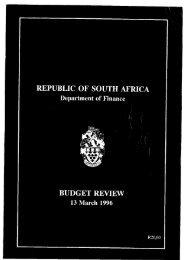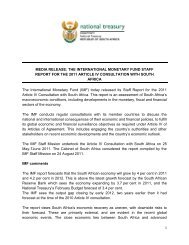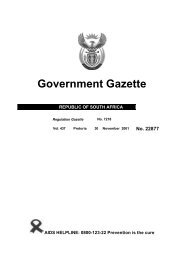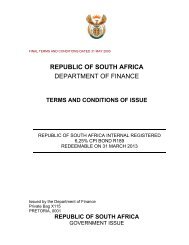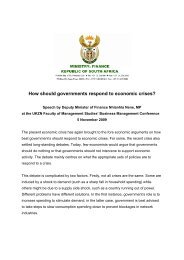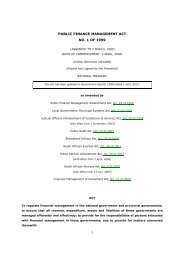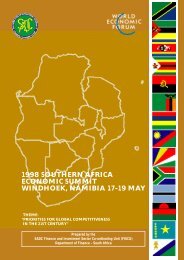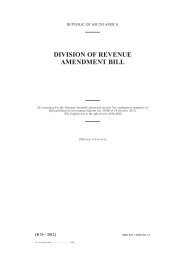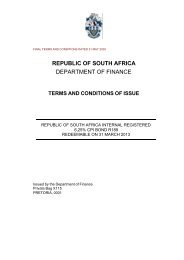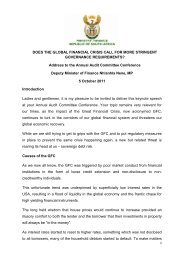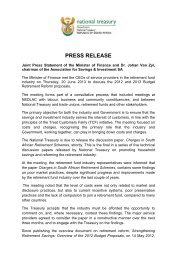Except in the case of Grade R at community sites and adult learning centres, the funding of the educational institutions mainly consists of the allocation of staff and the allocation of norms and standards funding. Grade R at community sites and adult learning centres receive norms and standards funding payments that are also used to pay teaching and administrative staff. By far the greatest portion of the budget goes to the primary and secondary school system including schools for LSEN. In the schools system, personnel are equitably allocated in terms of the post provisioning norms according to reported learner numbers, community poverty rankings and subjects offered. Norms and standards funding is allocated according to national poverty quintiles with the poorest quintile receiving on average six times more than the least poorest. Non-conditional and non-earmarked non-personnel expenditure represents 13,1% of total expenditure for the 2007/08 financial year. Non-personnel expenditure includes funds for norms and standards funding for public ordinary primary and secondary schools, learner transport schemes, infrastructure as well as for transfer payments to independent schools, public special schools, FET colleges, ABET centres and ECD schools and sites. Capital expenditure has decreased from 2,6% of the expenditure in 2003/04 to 2,2% of the estimated expenditure for 2007/08. This includes mainly provision for infrastructure projects as well as for computers and equipment for the Khanya Project. The reason for the decrease is due to the funding for the accelerated capital infrastructure delivery programme, which was made available in 2005/06 and 2006/07 financial years from the Asset Financing Reserve (AFR), being recouped from the department’s budget in future years commencing in 2007/08. Programme 2: Public ordinary school education continues to be the main focus of the department’s funding. 80,8% of the budget for 2007/08 is allocated to this Programme. The main services included under this Programme are primary and secondary school education at public ordinary schools (including infrastructure), the district office management and development support to educational institutions, human resource development for institution-based personnel as well as the <strong>National</strong> School Nutrition Programme conditional grant. 57% of the Programme’s budget is allocated to primary schools and 38% to secondary schools. Programmes that have had considerable growth from 2003/04 to 2007/08 are Programme 7: Early childhood development where additional resources have been provided to promote participation in Grade R as well as for the EPWP to provide for the training of ECD practitioners at ECD sites as well as to provide resource kits for these sites, Programme 5: Further education and training, where funds have been provided for the re-capitalisation of FET Colleges and Programme 8: Auxiliary and associated services where funds have been specifically provided for the further roll-out of the HCDS in line with the provincial development strategy, iKapa elihlumayo. For the past five years there has been almost universal enrolment in Grade 1 in the Western Cape and universal participation is maintained in the primary school. In other words, the overwhelming majority of Western Cape children between the ages of 7 and 14 are enrolled in the education system at more or less the appropriate grade level. However, there is a dramatic drop off in enrolment after Grade 8 and more recently Grade 10. Quantitative analysis of the Western Cape school enrolment figures by various researchers indicates that only 45 – 52% of learners who enroll in Grade 1 reach Grade 12. (Crouch, 2002; van Wyk, 2003). <strong>Annual</strong> <strong>Performance</strong> <strong>Plan</strong> 2007/08 – 2009/10 19
ST001 PROVINCIAL EDUCATION SECTOR – Key trends 2009/10 Estimated 2008/09 Estimated 2007/08 Estimated 2006/07 Estimated 2005/06 Actual 2004/05 Actual REVENUE (R’000) Equitable share 5,596,033 6,292,822 6,705,146 7,394,980 8,252,859 9,160,349 Conditional grants 84,714 143,683 257,012 224,003 231,527 167,348 Donor funding 0 0 0 0 0 0 Other 0 0 132,062 47,000 0 0 Own Revenue 9,962 12,739 21,641 18,675 12,819 12,819 TOTAL 5,690,709 6,449,244 7,115,861 7,684,658 8,497,205 9,340,516 PAYMENTS BY PROGRAMME (R’000) 1 Administration 215,094 237,493 292,471 338,540 411,774 433,049 2 Public ordinary school education (see further split below) 4,772,661 5,348,558 5,796,342 6,209,951 6,837,404 7,593,938 3 Independent school subsidies 29,761 32,445 34,127 39,541 41,241 43,097 4 Public special school education 345,224 366,447 386,040 410,446 434,604 459,355 5 Further education and training 152,383 168,186 264,527 309,637 320,028 336,843 6 Adult Basic Education and Training 21,151 23,051 23,571 26,056 27,313 28,654 7 Early Childhood Development 60,135 74,477 107,397 153,039 214,782 225,204 8 Auxiliary and associated services 94,300 198,587 211,386 197,448 210,059 220,376 TOTAL 5,690,709 6,449,244 7,115,861 7,684,658 8,497,205 9,340,516 PAYMENTS FOR PUBLIC ORDINARY SCHOOL EDUCATION (R’000) 2.1 Public primary schools 2,722,031 2,981,194 3,246,205 3,542,307 3,884,667 4,283,379 2.2 Public secondary schools 1,845,868 2,139,444 2,294,094 2,361,540 2,589,776 2,855,587 <strong>Annual</strong> <strong>Performance</strong> <strong>Plan</strong> 2007/08 – 2009/10 20
- Page 1 and 2: Wes-Kaap Onderwysdepartement • IS
- Page 3 and 4: FOREWORD BY MEC I believe this APP
- Page 5 and 6: W e s t e r n C a p e E d u c a t i
- Page 7 and 8: Contents Glossary of terms.........
- Page 9 and 10: PART A: OVERVIEW AND STRATEGIC PLAN
- Page 11 and 12: 2. Improving the educational enviro
- Page 13 and 14: The following specific programme-ba
- Page 15 and 16: Figure 1 Data Source: 1995 - 2005:
- Page 17 and 18: The introduction of ‘no- fee scho
- Page 19 and 20: The representative Departmental Tra
- Page 21 and 22: c) The No-Fee Schools Policy was im
- Page 23 and 24: A.4 The way forward A.4.1 Pre-schoo
- Page 25: The re-capitalisation plans of the
- Page 30 and 31: 2009/10 Estimated 2008/09 Estimated
- Page 32 and 33: ST002 PROVINCIAL EDUCATION SECTOR A
- Page 34 and 35: B.1 Administration The following ar
- Page 36 and 37: • Master Systems Plan (MSP) Based
- Page 38 and 39: ST101 ADMINISTRATION - Key trends 2
- Page 40 and 41: ST102 ADMINISTRATION - Expenditure
- Page 42 and 43: B.2 Public ordinary school educatio
- Page 44 and 45: To ensure effective management and
- Page 46 and 47: All Grade 8 Mathematics teachers we
- Page 48 and 49: • Post Provisioning Norms The sta
- Page 50 and 51: • Learner Transport It is not alw
- Page 52 and 53: 2009/10 Estimated 2008/09 Estimated
- Page 54 and 55: ST201 PUBLIC ORDINARY SCHOOLING - K
- Page 56 and 57: 2009/10 Estimated 2008/09 Estimated
- Page 58 and 59: 2009/10 Estimated 2008/09 Estimated
- Page 60 and 61: ST204 PUBLIC ORDINARY SCHOOLING Sch
- Page 62 and 63: ST208 PUBLIC ORDINARY SCHOOLING Res
- Page 64 and 65: ST301 INDEPENDENT SCHOOL SUBSIDIES
- Page 66 and 67: ST302 INDEPENDENT SCHOOL SUBSIDIES
- Page 68 and 69: The rationalisation of special scho
- Page 70 and 71: B.5 Further Education and Training
- Page 72 and 73: ST501 FURTHER EDUCATION AND TRAININ
- Page 74 and 75: B.6 Adult Basic Education and Train
- Page 76 and 77: ST601 ADULT BASIC EDUCATION AND TRA
- Page 78 and 79:
While there is universal enrolment
- Page 80 and 81:
B.8 Auxiliary and associated servic
- Page 82 and 83:
Strategy: A Multi-Sectoral Framewor
- Page 84 and 85:
ST801 Auxiliary and Associated Serv
- Page 86 and 87:
Project Type Number of projects Nam
- Page 88 and 89:
APPENDIX A: PERFORMANCE MEASURES Th
- Page 90 and 91:
►PM210: Percentage of working day
- Page 92 and 93:
WCED SCHEDULE 1 - Organogram of the
- Page 94 and 95:
ISBN Number 0-621-37049-5 PR Number
- Page 96 and 97:
Die JPP is 'n stap vorentoe om ons
- Page 98 and 99:
AANGAANDE HIERDIE DOKUMENT Die Jaar
- Page 100 and 101:
TERMLYS Hieronder volg die definisi
- Page 102 and 103:
• Vir die 2007-MTBR, d.i. vir die
- Page 104 and 105:
• Verdere uitbreiding van graad R
- Page 106 and 107:
StatsSA projekteer dat interprovins
- Page 108 and 109:
Huidige inskrywingsgetalle vir open
- Page 110 and 111:
Die Projek het tot dusver uitgebrei
- Page 112 and 113:
d) Sterk skoolbestuur is krities om
- Page 114 and 115:
3.4 Verbetering van toegang tot die
- Page 116 and 117:
Die NKV word in graad 10 - 12 ingev
- Page 119 and 120:
DEEL B: SEKTOR-, PROGRAM- EN SUBPRO
- Page 121 and 122:
2009/10 Beraamde 2008/09 Beraamde 2
- Page 123 and 124:
2005/06 2006/07 2007/08 2008/09 200
- Page 125 and 126:
ST004 PROVINSIALE ONDERWYSSEKTOR In
- Page 127 and 128:
• Verseker dat die leerderopspori
- Page 129 and 130:
Ten einde die bevindinge van die Ou
- Page 131 and 132:
ST101 ADMINISTRASIE - Sleutelneigin
- Page 133 and 134:
ST102 ADMINISTRASIE - Besteding per
- Page 135 and 136:
Die volgende is van toepassing op s
- Page 137 and 138:
• Die ontwikkeling van 660 prinsi
- Page 139 and 140:
vraestelle aan alle betrokke skole.
- Page 141 and 142:
• Skoolsakebestuurskursus Om admi
- Page 143 and 144:
Ontleding van beperkinge en beoogde
- Page 145 and 146:
2005/06 2006/07 2007/08 2008/09 200
- Page 147 and 148:
ST202 OPENBARE PRIMêRE SKOLE - Sle
- Page 149 and 150:
ST203 OPENBARE SEKONDDêRE SKOLE -
- Page 151 and 152:
2009/10 Beraamde 2008/09 Beraamde 2
- Page 153 and 154:
ST206 OPENBARE GEWONESKOOLONDERWYS
- Page 155 and 156:
B.3 Subsidies aan onafhanklike skol
- Page 157 and 158:
ST302 SUBSIDIES AAN ONAFHANKLIKE SK
- Page 159 and 160:
Die rasionalisering van spesiale sk
- Page 161 and 162:
B.5 Verdere Onderwys en Opleiding D
- Page 163 and 164:
Ontleding van beperkinge en beoogde
- Page 165 and 166:
2009/10 Beraamde 2008/09 Beraamde 2
- Page 167 and 168:
• Verbeterde monitering van leerd
- Page 169 and 170:
B.7 Vroeëkinderontwikkeling Die vo
- Page 171 and 172:
ST701 Vroeëkinderontwikkeling - Sl
- Page 173 and 174:
• Om voorsiening te maak vir toep
- Page 175 and 176:
Onderwyseropleiding Hierdie inisiat
- Page 177 and 178:
B.9 Implementering van kapitale inv
- Page 179 and 180:
Die volgende maatreëls is geneem o
- Page 181 and 182:
►PM104: Persentasie huidige beste
- Page 183 and 184:
►PM401: Persentasie kinders met s
- Page 185:
False Bay FET Colleges Valsbaai VOO
- Page 188 and 189:
ISBN Number 0-621-37049-5 PR Number
- Page 190 and 191:
Ukugxininisa kwi-Early Childhood De
- Page 192 and 193:
MALUNGA NOLU XWEBHU IsiCwangciso es
- Page 194 and 195:
IINKCAZELO ZAMAGAMA NAMABINZA Iinkc
- Page 197 and 198:
ISIGABA A: USHWANKATHELO NOHLAZIYO
- Page 199 and 200:
• Uphuhliso nosungulo lwesigaba s
- Page 201 and 202:
nokusebenzisa ooGunyaziwe abohluken
- Page 203 and 204:
Itheyibhile 1: Ubhaliso kwizikolo z
- Page 205 and 206:
1 Ama-40% oluntu ongasebenziyo apha
- Page 207 and 208:
2. IsiCwangciso soLingano kwezeNgqe
- Page 209 and 210:
) Iqela eliza kulawula inkqubo ye-Q
- Page 211 and 212:
i) Uphuculo oluqhubekayo lofikelelo
- Page 213 and 214:
2. Icandelo le-GET (amaBanga 1-9) I
- Page 215:
Uncediso-mali lophuculo alujoliswan
- Page 218 and 219:
Uhlalutyo lokuhamba komsebenzi Inkc
- Page 220 and 221:
ST001 ICANDELO LEMFUNDO YEPHONDO -
- Page 222 and 223:
ST002 ICANDELO LEMFUNDO YEPHONDO Am
- Page 224 and 225:
B.1 Ulawulo Ezi zilandelayo ziinjon
- Page 226 and 227:
Lo msebenzi ubaluleke kakhulu kwi-W
- Page 228 and 229:
ST101 ULAWULO - Iindlela eziphambil
- Page 230 and 231:
ST102 ULAWULO - Inkcitho ngenkalo n
- Page 232 and 233:
Oku kulandelayo kuphathelele kumset
- Page 234 and 235:
• Uphuhliso lweenqununu nootitsha
- Page 236 and 237:
Isebe liza kungenelela ngokuthe ngq
- Page 238 and 239:
UMphathiswa weSizwe weMfundo wathat
- Page 240 and 241:
Ngexesha lokugqithiswa komsetyenzan
- Page 242 and 243:
ST201 IZIKOLO ZEMFUNDO ZESIQHELO -
- Page 244 and 245:
ST202 IZIKOLO ZASEPRAYIMARI ZIKARHU
- Page 246 and 247:
ST203 IZIKOLO ZASESEKONDARI ZIKARHU
- Page 248 and 249:
ST203 IZIKOLO ZASESEKONDARI ZIKARHU
- Page 250 and 251:
ST206 IZIKOLO ZIKARHULUMENTE ZESIQH
- Page 252 and 253:
B.3 UNCEDISO-MALI LWEZIKOLO EZIZIME
- Page 254 and 255:
ST302 UNCEDISO-MALI LWEZIKOLO EZIZI
- Page 256 and 257:
Ukuhlengahlengiswa kwezikolo ezizod
- Page 258 and 259:
B.5 Imfundo Yecandelo Le-FET Ezi zi
- Page 260 and 261:
Uhlalutyo lwemiqobo namanyathelo ac
- Page 262 and 263:
ST501 IMFUNDO YECANDELO LE-FET - Ii
- Page 264 and 265:
• Uhlanganiso ne-ICT kwinkqubo yo
- Page 266 and 267:
B.7 Imfundo yabantwana abaqalayo Ez
- Page 268 and 269:
ST701 IMFUNDO YABANTWANA YASEKUQALE
- Page 270 and 271:
• Ukuphuhlisa inkqubo yolawulo es
- Page 272 and 273:
Inkqubo emanyeneyo yabalingane i-Go
- Page 274 and 275:
ST801 IINKONZO ZONCEDISO NEZINXULUM
- Page 276 and 277:
B.9 Ukusetyenziswa Kwesicwangciso S
- Page 278 and 279:
uphicotho lwempahla engenakususwa (
- Page 280 and 281:
►PM102: Ipesenti yezikolo ezinako
- Page 282 and 283:
►PM220: Umlinganiselo wempumelelo
- Page 284:
Northlink FET College e-Northlink k



